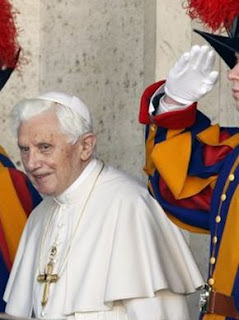Medlem i FSSPs ‘Confraternity’
Petersbroderskapet (FSSP – stiftet i 1988) er den gruppen av prester som feirer den tradisjonelle messen, som jeg føler meg mest tiltrukket av. For to uker siden var jeg og beøkte dem i Sveits, og i dag har jeg meldt meg inn i deres støttegruppe (Hva kan Confraternity kalles på norsk?). Les mer om denne gruppen bl.a. HER. For noen uker siden (22/2) var denne støttegruppen 5 år, og da skrev lederen, Fr Armand de Malleray, bl.a. følgende om den:
Following a resolution by the last General Chapter (2006) of the
Priestly Fraternity of St Peter, the Confraternity of Saint Peter was
founded on 22 February 2007 as an answer to the petitions of fellow
Catholics desiring to be more closely associated to the ministry of our
Fraternity. Not being a religious order, we do not run a third order as
such, but we could offer our faithful the support of a sodality. From
medieval times sodalities had proved a deeply traditional and efficient
way of sanctification for the laity and for the clergy: such time-proofed
instruments are not obsolete in the current dechristianisation. This is to
our mutual advantage, as CSP members and FSSP members pray for each other
and support each other according to our respective vocations.Five years later the Confraternity numbers 3,750 worldwide.
As members (Catholic with minimum age fourteen) you commit to: every day:
1) pray one decade of the Holy Rosary for the sanctification of our
priests and for our priestly vocations, 2) and recite the Prayer of the
Confraternity; and every year: 3) have the Holy Sacrifice of the Mass
offered once for these intentions. …Dear Friends, the ‘Master of the Harvest’ hears you!
Our international seminaries have been blessed with an unprecedented
intake of 49 and 44 applicants in the last two years, bringing the total
number of our seminarians to 162 – over 80 in each of our seminaries.
Furthermore, whereas many religious and diocesan institutions undergo
dramatic variations, the number of our priestly ordinations is
characterised by a remarkable stability, with an average 12 priests
ordained each year since 2000. Undoubtedly, your dedication and
intercession as members of the Confraternity of Saint Peter are a decisive
factor in those achievements. Thankfully, even more people outside the
Confraternity pray for us daily: but the 3,750 of you do so with the
intention of fulfilling a formal commitment, whence increased merits and
graces….Please note that the Confraternity is not for lay Catholics only. From the beginning, consecrated persons, either religious or clerics, have been expected to join as well. To this date, over a hundred have. In Great Britain only, for example, already ten parish priests have joined the Confraternity. There are no extra commitments for clergy. The only difference is that priest members would offer the annual Mass for the Confraternity themselves, rather than have it said by another priest. Especially when they feel isolated and sidelined due to their courageous attachment to the Roman traditions, religious and diocesan priests (and future priests) find spiritual solace in joining the Confraternity as added members of our priestly family …

 For å forstå hvorman og hva man skal synge i liturgien (dvs. messen ordinarium og proprium), kan man kjøpe boken
For å forstå hvorman og hva man skal synge i liturgien (dvs. messen ordinarium og proprium), kan man kjøpe boken  Sist søndag presenterte kardinal Antonio Cañizares Llovera, prefekt for Liturgikongregasjonen, en bok skrevet av Msgr. Guillaume Derville, kalt «La concélébration eucharistique. Du symbole à la réalité».
Sist søndag presenterte kardinal Antonio Cañizares Llovera, prefekt for Liturgikongregasjonen, en bok skrevet av Msgr. Guillaume Derville, kalt «La concélébration eucharistique. Du symbole à la réalité». I dag – 2. mars – er pave Benedikt eldre enn pave Johannes Paul II var da han døde –
I dag – 2. mars – er pave Benedikt eldre enn pave Johannes Paul II var da han døde –